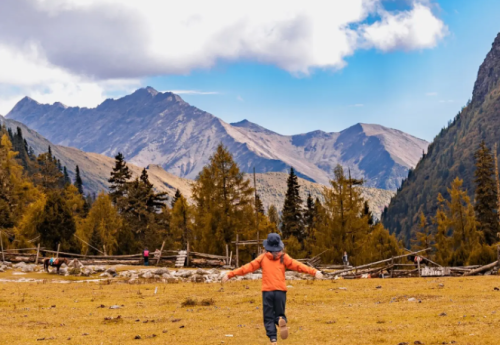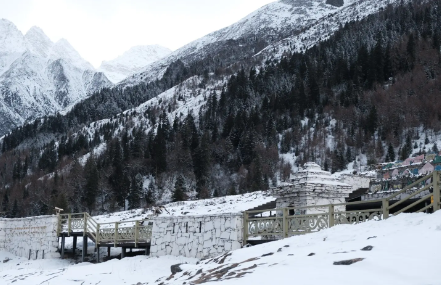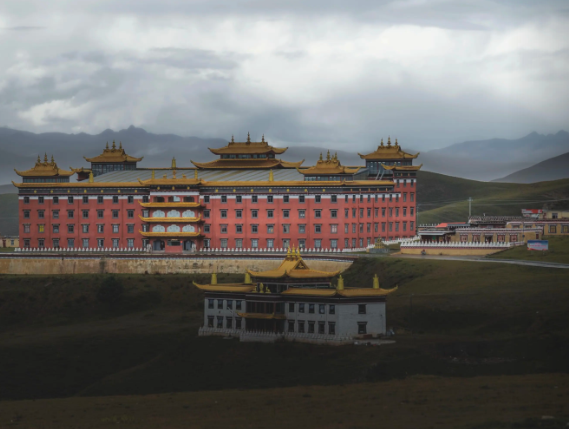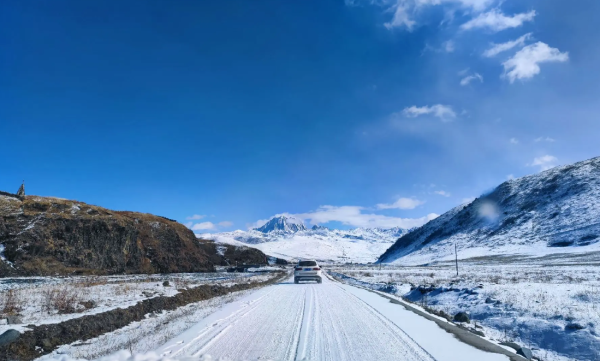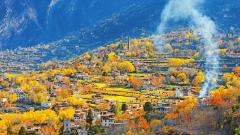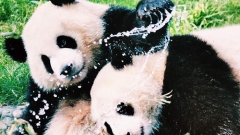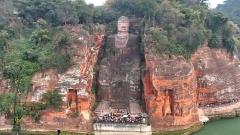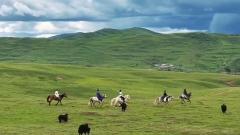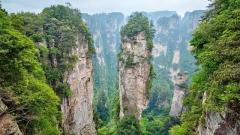Western Sichuan is a dreamland for hikers — a region where the vast Tibetan Plateau meets rolling valleys, snow-covered peaks, and tranquil lakes. While many assume hiking season ends after autumn, winter reveals a quieter, more majestic side of Sichuan. Frozen forests, golden sunlight, and crystal-clear mountain air make every step unforgettable. Whether you’re chasing panoramic snow views or exploring hidden Tibetan villages, winter hiking in Western Sichuan offers solitude, adventure, and scenery found nowhere else in China.
Hailuogou Glacier Park – Ice and Fire in One Place
Location: Luding County, Garze Tibetan Autonomous Prefecture
Best for: Beginners and nature photographers
Hailuogou is one of Western Sichuan’s most accessible winter hiking destinations, famous for its massive glacier, snow forests, and hot springs. The main hiking trail starts at Camp No. 1 and leads through ancient forests to viewpoints overlooking the spectacular No. 1 Glacier and Gongga Mountain, known as “the King of Sichuan Peaks.”
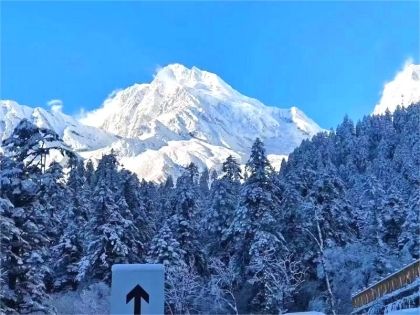
Winter Hailuogou
In winter, the contrast of frozen waterfalls and steaming hot springs creates a surreal experience. After a morning hike, relaxing in the Moxi Hot Springs surrounded by snow is pure bliss.
Tips:
-
Dress warmly — temperatures can drop below -10°C near the glacier.
-
The lower trails are open year-round, but upper sections may be restricted after heavy snow.
-
Don’t miss sunrise at Camp No. 4, when the first light hits Mount Gongga’s summit.
Mount Siguniang – The “Alps of the East”
Location: Xiaojin County, Aba Prefecture
Best for: Intermediate to advanced hikers
Mount Siguniang, or Four Sisters Mountain, is one of the most iconic trekking areas in Western Sichuan. It consists of three main valleys — Shuangqiao, Changping, and Haizi — each offering distinct winter experiences.
-
Shuangqiao Valley: The easiest route, accessible by shuttle bus, with boardwalks through snowy forests and frozen rivers.
-
Changping Valley: A scenic hiking trail (around 20 km) leading deep into Tibetan villages and open meadows framed by snow peaks.
-
Haizi Valley: Best for those seeking solitude and winter camping.
In winter, the air is crisp and visibility excellent — perfect for photographing the snow-capped Four Sisters Peaks, which reach up to 6,250 meters.
Tips:
-
The area remains open year-round, but proper cold-weather gear is essential.
-
Local Tibetan guesthouses provide basic lodging and hot meals.
-
Avoid high-altitude hikes if you’re not acclimated.
Yading Nature Reserve – The Sacred Mountains of Daocheng
Location: Daocheng County, Garze Prefecture
Best for: Experienced trekkers and photographers
Known as “the last Shangri-La,” Yading is one of the most breathtaking hiking destinations in China. The three sacred peaks — Chenrezig (Xiannairi), Jampelyang (Yangmaiyong), and Chanadorje (Xianuoduoji) — are considered holy in Tibetan Buddhism.
The classic Yading kora trail circles around these peaks, offering views of frozen lakes, snow-covered meadows, and crystal-clear skies. In winter, the crowds disappear, leaving only silence and nature’s grandeur.
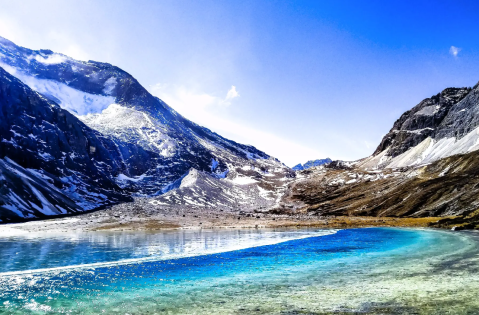
Shorter trails such as the route to Milk Lake or Five-Color Lake are perfect for those who prefer a moderate winter hike.
Tips:
-
Temperatures drop below -20°C; pack insulated layers, waterproof boots, and sun protection.
-
The park’s eco-buses operate with limited schedules in winter — check ahead.
-
Ideal for photography: sunrise over Xiannairi is breathtaking.
Tagong Grassland – Hike Among Temples and Snow Peaks
Location: Kangding County, Garze Prefecture
Best for: Cultural hiking and short scenic walks
The Tagong Grassland offers a rare mix of Tibetan culture and mountain scenery. Surrounded by snow-covered meadows and dotted with yak herds, it’s a peaceful destination for travelers seeking a more cultural experience.
Winter hikes around Tagong Monastery, Muya Golden Pagoda, or Yala Snow Mountain Viewpoint are ideal for half-day or full-day explorations. The horizon often glows golden at sunset, with prayer flags fluttering in the icy wind.
Tips:
-
Roads to Tagong remain open in winter, though snow can occasionally delay transport.
-
Bring sunglasses — the plateau sun is strong even in cold weather.
-
Try a homestay with local Tibetan families for authentic warmth and food.
Mugecuo Lake (Kangding) – Serenity in the Snow
Location: Kangding, Garze Prefecture
Best for: Leisure hikers and families
Mugecuo Lake, also known as “Wild Man Lake,” is surrounded by forested hills and geothermal springs. In winter, the area transforms into a quiet paradise of frozen lakes, frost-covered pines, and misty mountains.
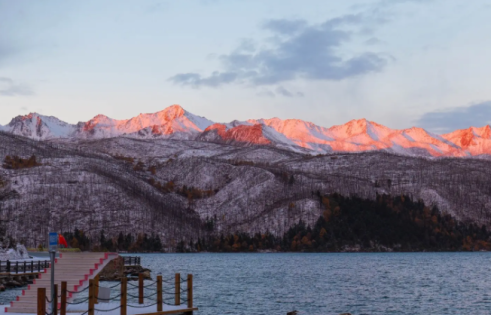
You can follow the boardwalk trail around the lake, which remains accessible year-round. Some sections lead to hot spring areas and panoramic viewpoints. The air is incredibly pure, and the calm atmosphere makes it perfect for reflection or easy nature walks.
Tips:
-
Dress in layers; the temperature difference between sun and shade is large.
-
Visit early morning for the best reflection views before the wind rises.
-
Combine with a stop in Kangding town for local yak hotpot.
Xinduqiao – Photographer’s Paradise on Foot
Location: Between Kangding and Tagong
Best for: Easy hikes and photography lovers
Often called the “Photographers’ Town,” Xinduqiao is a charming valley filled with Tibetan houses, golden meadows, and snow peaks. Winter brings fresh snow and crisp air — the perfect time for short day hikes through villages, riversides, and fields glowing under morning frost.
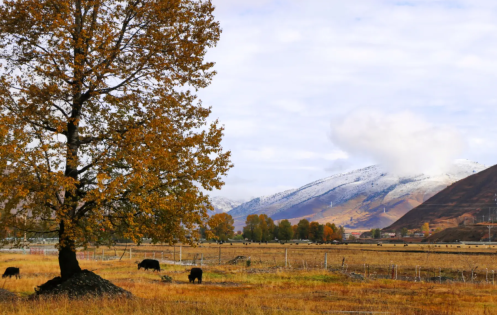
The short trails near the Zheduo Mountain Pass offer panoramic views of Gongga Mountain under blue winter skies.
Tips:
-
Ideal for casual hikers who want to enjoy scenery without high-altitude challenges.
-
Early morning and sunset light are perfect for landscape photography.
-
Bring hand warmers — temperatures can drop below -15°C before dawn.
Essential Winter Hiking Tips for Western Sichuan
-
Dress in Layers: Base layer (thermal), mid-layer (fleece), and outer (windproof and waterproof).
-
Footwear: Waterproof hiking boots with good grip — trails can be icy.
-
Stay Hydrated: The dry air at altitude dehydrates you faster than you realize.
-
Acclimatize Gradually: Western Sichuan sits 2,500–4,000 m above sea level.
-
Respect Local Culture: Many areas are Tibetan — always walk clockwise around stupas and avoid touching prayer flags.
-
Weather Check: Snowstorms are rare but possible; verify local forecasts before heading out.
-
Travel Insurance: Make sure it covers high-altitude hiking.
Why Hike in Western Sichuan in Winter?
-
Fewer Tourists: Popular spots like Yading and Siguniang are almost empty.
-
Unreal Beauty: Clear skies, snow peaks, and magical light make for world-class photography.
-
Local Hospitality: Fewer travelers mean more chances to connect with Tibetan locals.
-
Affordable Travel: Off-season hotel and transport rates are 20–40% cheaper.
Conclusion
Winter hiking in Western Sichuan is an experience for the senses — quiet, raw, and deeply spiritual. Whether you’re walking across frozen valleys in Yading, soaking in Hailuogou’s hot springs after a glacier hike, or watching sunrise at Mount Siguniang, you’ll find that the stillness of winter brings out the region’s purest charm. For those who seek solitude and beauty away from the crowds, this is the perfect season to lace up your boots and discover the wild heart of Sichuan.



